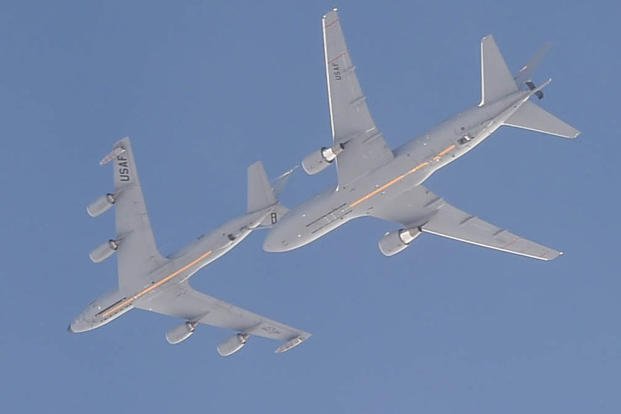The U.S. Air Force is trying to extend the life of 28 of its oldest aerial refueling tankers because of mission demand, compounded by delays for its newest tanker, the KC-46 Pegasus.
Gen. Stephen Lyons, head of U.S. Transportation Command, told the Senate Armed Services Committee on Tuesday that the service is "working currently to delay the divestiture of a select number of [KC-135 Stratotankers] so that we don't have this exorbitant dip in [tanker] capability over time."
Lyons said the idea has been well received so far by top Air Force leadership. "Obviously, it's going to cost money and, when the money is put into the program, that's when we'll know. But the intent is to retain 28 weapon systems beyond their currently scheduled retirement," he said.
His comments come after the service ordered a halt in KC-46 deliveries, citing foreign object debris found in some of the aircraft. As of Tuesday, the Air Force still isn't accepting the Pegasus on its flight lines, marking two weeks since the stand-down, a service spokeswoman told Military.com.
Related content:
- Mattis Orders Supercharge in Fighter Jet Readiness
- Air Force Halts Delivery of New KC-46 Tankers over Debris Inside Aircraft
- Will Ongoing KC-46 Tanker Problems Affect KC-10 Retirement?
The KC-46 is scheduled to replace part of the service's older tanker fleets, such as the KC-135 and KC-10 Extender.
The Air Force said its goal is to retire its KC-10s and have the right mix of KC-46 and KC-135 aircraft to meet its 479 tanker requirement. The service will gradually phase out its older aircraft, as well as portions of its KC-10 fleet, beginning in the 2020s as it adds KC-46s.
Though the KC-10s are much younger (the modified McDonnell Douglas DC-10 air tankers deployed for the first time in 1981, while the KC-135 fleet dates back to the 1950s), the KC-135 fleet is expansive: There are 396 Stratotanker R/T variants across the total force, while the KC-10A fleet numbers 59 in the active component only, Air Mobility Command told Military.com last year. Two additional KC-135s reside with Air Force Materiel Command for testing.
Though older, the sheer size of the KC-135 fleet means it is more readily available for operations.
Lyons would not say how much longer the Air Force will keep the 28 KC-135s past their intended retirement, but said that maintainers are working "very, very hard" to improve the overall readiness rate of the fleet
The KC-135 fleet's average mission-capable rate stands at 74 percent, according to fiscal 2017 numbers reported by Defense News. Mission-capable rates measure how effectively aircraft can be ready for their primary mission, or to deploy at a moment's notice.
"In the KC-135 fleet, for example, we're unable to meet that 85 percent goal," Lyons said Tuesday, referencing the service's stated goal of 80 to 90 percent readiness for its aircraft fleets. "The Air Force is working very, very hard to improve that readiness in the near term. That would generate more tails available for mission."
In written testimony to the committee, Lyons said the service, with the help of Congress, will see what fleet numbers it has to work with "over the next decade."
"We strongly advocate for continued congressional support to enhance tanker readiness and balance new aircraft fielding with aging aircraft divestiture in order to retain the necessary number of accessible [tanker] assets over the next decade," he wrote.
Even as the KC-46 continues to experience setbacks, Lyons told lawmakers "the decision to deliver, I think, was a good one."
Boeing Co. was supposed to deliver the initial 18 aerial refueling planes by August 2017. After a series of delays, the first aircraft was transported from Boeing's Washington state facility to McConnell Air Force Base, Kansas, on Jan. 25.
The Air Force announced earlier this year that it would accept the tanker, which is based on the 767 airliner, despite the fact it still has deficiencies, predominantly with its remote vision system, that Boeing has agreed to fix after delivery.
The systemic issue, which will require a software and hardware update, may take three to four years to fix, officials have said.
-- Oriana Pawlyk can be reached at oriana.pawlyk@military.com. Follow her on Twitter at @Oriana0214.










